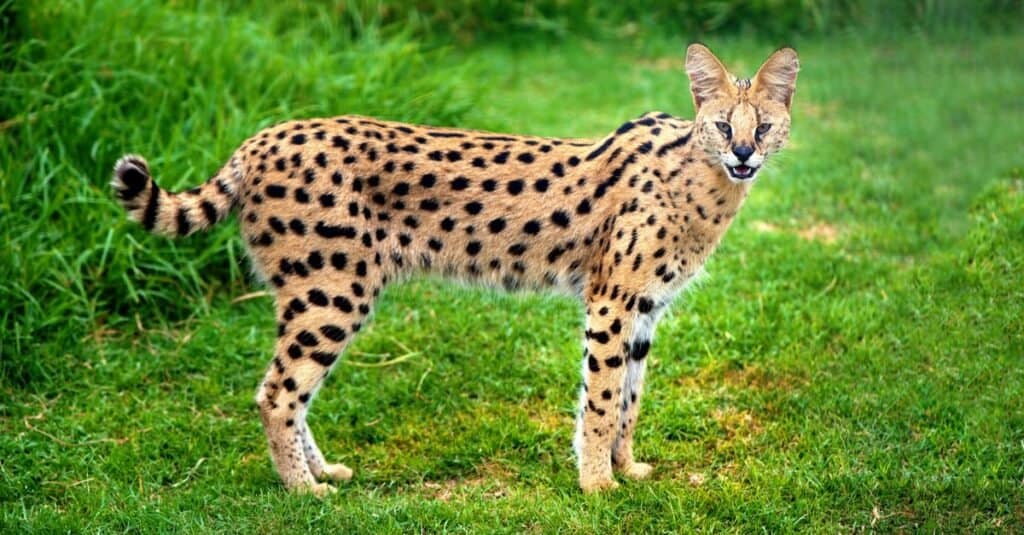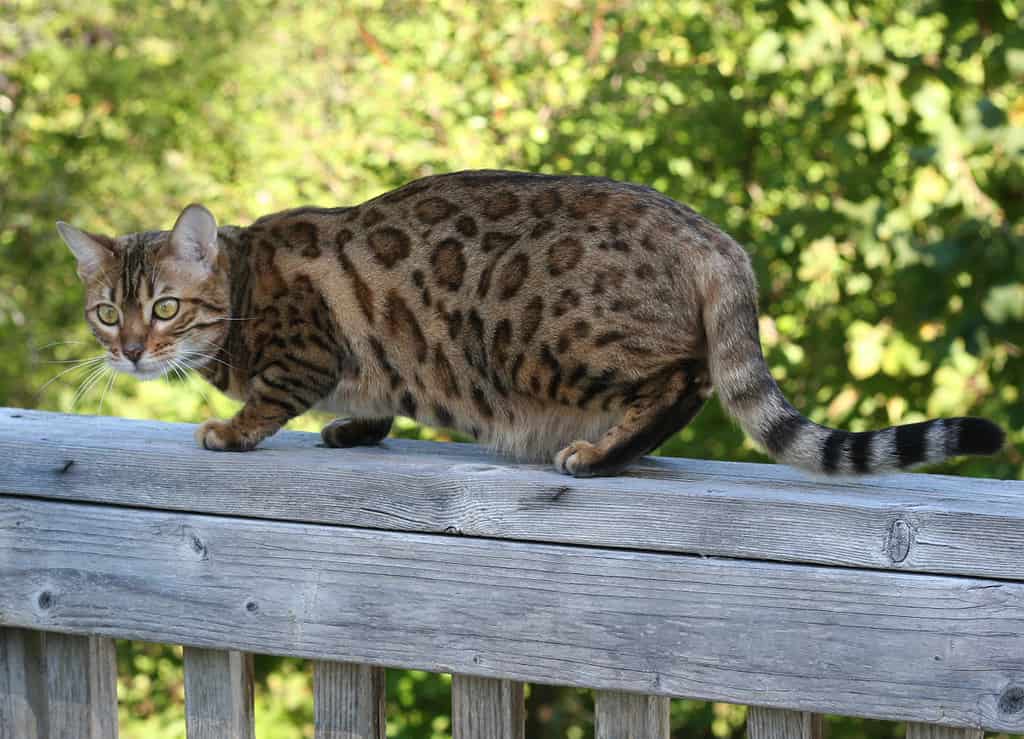The title of the most expensive cat breed ever sold belongs to the Ashera cat. Produced by a single company, Lifestyle Pets (ALLERCA), some kitties sold for as much as $175,000. The average Range Rover sells for $104,000 in the United States as of 2023. When buyers discovered the entire thing was an elaborate scam, tempers rose, and the company eventually shut down. Let’s learn more about the Ashera cat breed and what happened to cause such a fuss!

Lifestyle Pets claimed the Ashera cat came from cross-breeding with African servals. This was the only truth to their statements.
©Howard Klaaste/Shutterstock.com
The Ashera Cat
The Ashera cat claimed to be a new breed created from mixing African serval, Asian leopard cat, and domestic cat genes together. They appeared to be an amazing new breed when they surfaced around 2006. People became very excited about the chance to own one of these extremely exclusive pet cats. The company stated they would produce only 100 kittens per year. Only 50 would be sold within the United States. By presenting them as a rare commodity, Lifestyle Pets was able to generate a ton of interest. Unfortunately, their buyers were largely uninformed and bought into the hype.
Lifestyle Pets pushed its agenda a bit further to raise the price. By claiming the Ashera cat to be the only scientifically proven hypoallergenic cat, they could charge even more. They even used the name of a highly renowned allergist at UCLA (Dr. Sheldon Spector, now deceased) in their reports. They stated he studied the cats and declared them hypoallergenic. Dr. Spector didn’t actually say that. In fact, he told reporters that his 5-page paper about the Ashera cat didn’t prove anything.
Nevertheless, the thought of adding the hypoallergenic aspect was brilliant in terms of making money. It played well to the public since so many people who love cats are violently allergic to them.
Scamming the Public: The Ashera Cat Fraud Uncovered
What the buyers didn’t realize is that the Ashera cat was just too good to be true. Suspicions arose when a Savannah cat breeder made a report to San Diego’s Union-Tribune. He claimed that the Ashera cats Lifestyle Pets was selling were actually cats they’d purchased from him. The concern didn’t stop there.
Busting the Ashera Cat Breeder
Determined to get to the bottom of the situation, ABC News actually arranged to purchase an Ashera cat from Lifestyle Pets in 2013. Then they set up a surprise interview to catch Simon Bodie (the owner of Lifestyle Pets) in his lies. When he was confronted, Mr. Bodie first claimed he had not purchased the Ashera kitten from anyone else.
The anchor continued to pressure Mr. Bodie. He told Mr. Bodie that he would call the breed of the cat right then and confirm that they sold the Ashera kitten. Furthermore, the anchor knew Mr. Bodie only paid £150 (or roughly $260). Hearing this, the scammer began to become visibly uncomfortable.
Mr. Bodie quickly began to backtrack. He finally confessed he did purchase the cat from another breeder and that he couldn’t guarantee it was hypoallergenic. His “facts” quickly turned to “I believe” statements. He offered to send the news station “reams upon reams of scientific data” to back up his claims. The pair agreed on a 30-day window for this proof. Months later, the 5-page report from Dr. Spector arrived.
The anchor even told Mr. Bodie that the new station paid to have several of the cats genetically tested. The results concluded that not a single one produced fewer allergens. There was no scientific or genetic proof that Ashera cats were more hypoallergenic than any other cat.
As if That Wasn’t Enough…
Not only were they not hypoallergenic, but further genetic studies proved that the Ashera cats weren’t even a separate breed. The cats contained no Asian leopard cat DNA, only that of African serval and domestic cats. That means the cats were Savannah cats. This breed had been around for much longer, and kittens were significantly less expensive. Furthermore, Mr. Bodie didn’t even breed them. He purchased all the cats he sold from other breeders and then resold them with a massive markup!

Do Hypoallergenic Cats Exist?
Unfortunately, there is no cat breed in existence that is proven hypoallergenic. That means there are zero breeds that will not produce any allergic reaction for all people with cat allergies. Some breeds however, such as the Bengal, have the potential to be hypoallergenic cat breeds for some people. Other breeds include Siberian and Sphynx. The real Ashera cats (Savannahs) may also fit into this group. The hypoallergenic aspect depends on many factors both with the individual cat and the person.
Previously, it was thought this was due to the cats producing less Fel d 1 protein. That’s the chemical produced in cat saliva that is thought to produce most cat allergies. This is the same reasoning used by Mr. Bodie despite his lack of real scientific proof. However, there are actually seven of these proteins that cause people’s allergies to cats. No breed has been proven to produce less of them.
Bengals and Savannahs may not produce fewer allergens, but they are still considered hypoallergenic. That’s because they have such a close-lying fur coat that doesn’t require as much grooming as other cats. So, Bengal cats tend not to lick themselves as much as other cats might. They also shed less frequently. All this means these cats may spread less dander around the home for pet owners to react to. Dander is just dried saliva that flakes off the coat and into the surroundings.
Allergy sufferers can take steps to reduce their likelihood of reacting to their cats. These include bathing them often, washing their own hands after handling them, and keeping their cats out of the bedroom. One study aims to create allergen-reducing cat food, though it’s not on the market yet.
The photo featured at the top of this post is © Mirencats/Shutterstock.com
Thank you for reading! Have some feedback for us? Contact the AZ Animals editorial team.







